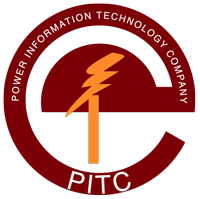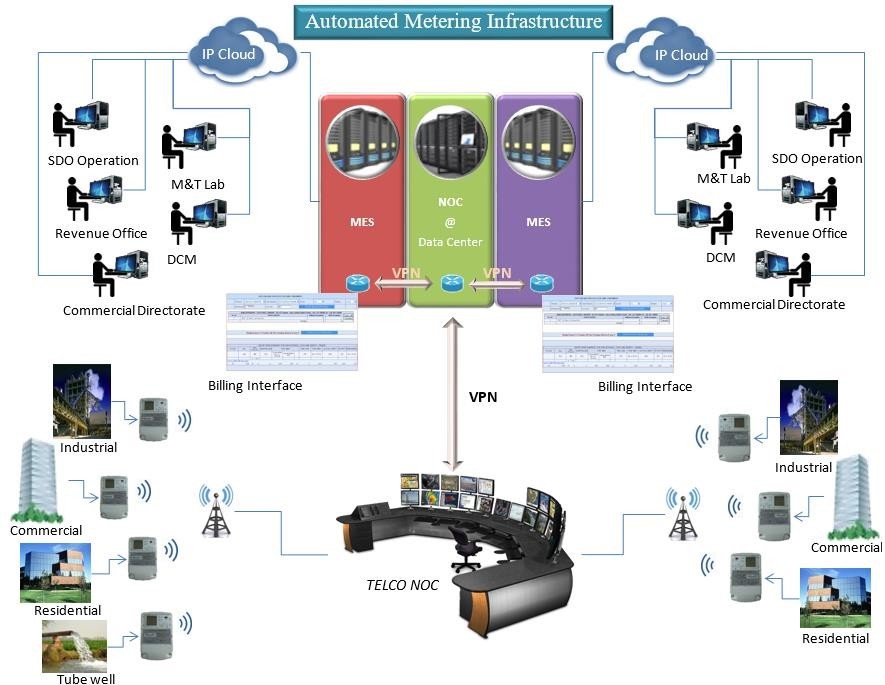Automated Metering Infrastructure (AMI)
PITC will implement smart grid across all Garrisons where HES will be installed initially at PITC’s data center in colocation mode; however, the same will be shifted to air gapped / controlled data center established by MES on as and when required. All Garrisons will be provided remote access through secure private and self-healing physical and logical VPN links to the meter data repository applications hosted at the NOC central hosting facility to use the meter readings for billing and analyses. The project introduces AMR system to help reducing distribution losses, enhancing load control and load management, providing automated consumption (billing) data collection of customers, improving revenue collection and customer service, reducing billing complaints and operating costs, increasing operational efficiency and modernizing the electricity metering and billing operation.
To effectively implement the AMR project, it is imperative to constitute an Automated Metering Infrastructure (AMI) Cell within each CORPSE / Garrison to undertake the responsibilities of AMR system installation and operation. AMI Cell will coordinate AMR meter configuration, installation, communication and operation with different CORPSE / Garrison formations.
The Objectives of the AMI cell is to:
- Monitor and maintain AMI system, the MDC, the network and the User Interface software(s).
- Administrate user access and controls.
- Secure GSM/GPRS SIMs.
- Secure appropriate IP bandwidth and create self-healing secured Virtual Private Networks (VPNs) as required to operate the system.
- Manage Data Connectivity between the telecommunication service providers and NOC
- Operate Meter Data Communication software.
- Responding to AMR meter Alerts and events.
- Manage AMR meter data repository.
- Support the management to access the metering information and provide special reports.
- Disseminate information to multiple authorized end users.
- Uploading load management plans.
- Processing remote disconnect and reconnect functions.
- Prepare requirement documents to define the desired functionality requirements.
- Ensure proper day to day operations of the AMI system, i.e. purchasing of SIMs, assigning static IP addresses, establishing one to one relation of static IP with consumer reference number and ensuring connectivity.
- Extract and report data for billing and other allied customer care applications.
- Perform periodic backups, transferring of data from MDC to data warehouse etc.
- Provide technical assistance to field operation.
- Plan system augmentation and upgrades to keep pace with the rapidly changing IT technology.
- Ensure project expansion and sustainability.
- Disaster Recovery and maintenance.
- Administer Equipment and Software warranties.

Technical Integration of AMI Cell with Utility Function
AMI Cell Structure
The cost of network, security and data center for the MDM project is included as common cost of data center and central services; however, the cost components of MDM hardware deployment is presented below and respective project time lines are presented in project execution plan annexed at Annex 2. Moreover, the relevant standards for compliance testing and smart meters specifications are placed at Annex 3. The snapshot of the MDM system is presented above and same will be customized according to the structure of HQrs, Corpse, MES and Garrisons.
The organizational requirement for AMI cell is proposed as under; however, MES may decide to augment the roles in one designation as per their availability of resources:
Sr. | Designation | Role | Qty. |
1. | Deputy Manager (AMI) | Operations | 1 |
2. | Assistant Manager (MDC) | Head End Systems | 1 |
3. | Assistant Manager (MDM) | MDM | 1 |
4. | Assistant Manager (Field Operations) | Field Services | 1 |
5. | Assistant Manager (Network) | Network Operations | 1 |
Smart Metering Rollout Strategy
- Establish Advanced Metering Infrastructure (AMI) Cell with dedicated resources and organizational structure as presented in this document.
- Develop technical capacity of Metering & Testing (M&T) department to undertake the responsibility of keeping the smart meter fleet healthy and operational in coordination with AMI Cell and telecommunication companies.
- Conduct a pre audit of the available data for potential customers who will be equipped with the smart meter in collaboration with field operations, M&T and revenue offices.
- Smart meters and associated MDCs must comply with the latest UDIL standards.
- Smart meters must be configurable for bi-directional use and may be pre-configured as unidirectional.
- The primary communication medium for 3-phase smart meters shall remain as General Packet Radio Service (GPRS) – 3G/4G with backward compatibility; however, if required meters can be manually read through mobile meter reading system (MMRS) as presented in Section 5.
- PITC to commence extensive training sessions for MES AMI Cell, M&T, Commercial and Customer Services departments to build their capacity for using MDM and timely attending the critical alarms as generated by the smart meters.
- Participate in and witness UDIL compliance testing at PITC, factory acceptance and site acceptance tests of the smart meters.
- Assign the required staff and empower them with the requisite authority to complete desired tasks.




